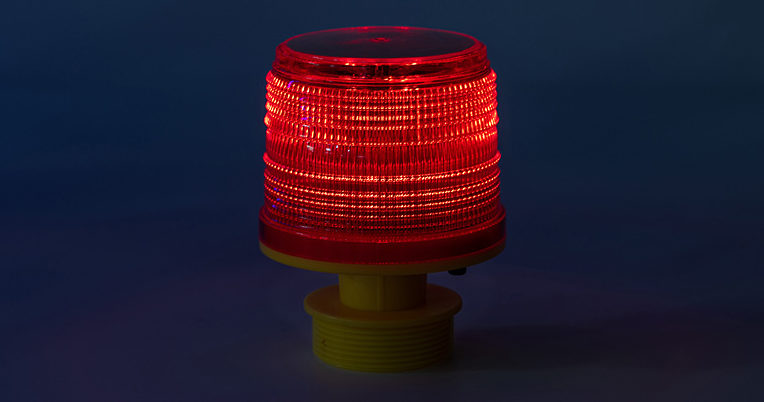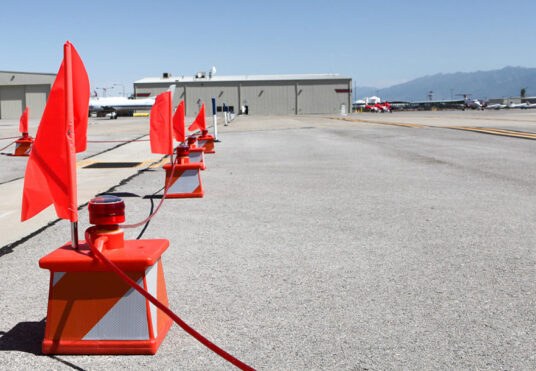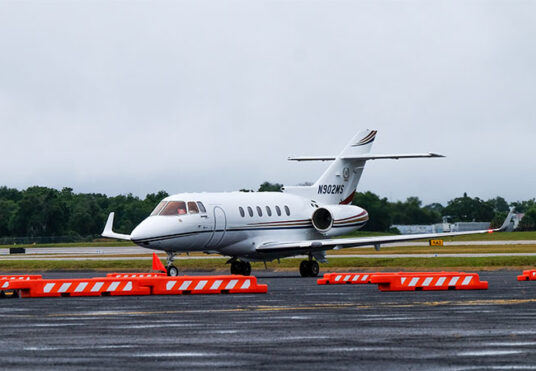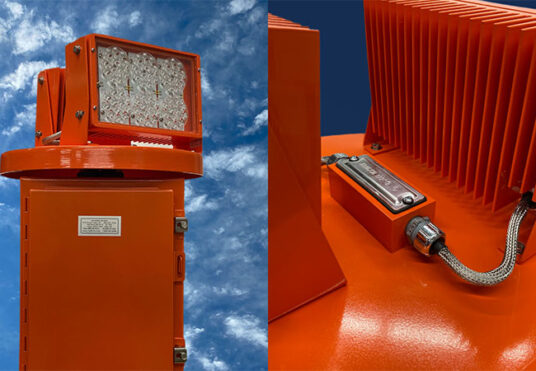Everything You Need to Know About Airport Hazard Lights

Our new and improved airport hazard light (AHL) is one for the books – we took our customers’ feedback, regulatory updates from the Federal Aviation Administration (FAA), and industry best practices, to guide the development of our newest airport product, and the results speak for themselves! At OTW Safety, we understand that product dependability is crucial on any construction site. Airports are an especially challenging environment because in most cases, flying operations continue throughout the project and a product failure can have serious consequences. From top to bottom, the AHL was designed for reliability: we equipped it with powerful LEDs and enhanced solar efficiency, and we really think we knocked it out of the park!
How is the Airport Hazard Light powered?
The AHL is a multifunction, solar-powered warning light that easily attaches to all of our airport barricades. Pair it with your chosen barricade and, with a simple push of a button, select steady or flashing mode based on the airport requirements. A rechargeable battery is included and installed in each AHL, reducing the time it takes to deploy the product.
How does solar power work?
According to the Office of Energy Efficiency and Renewable Energy, “solar technologies convert sunlight into electrical energy either through photovoltaic (PV) panels or through mirrors that concentrate solar radiation. This energy can be used to generate electricity or be stored in batteries or thermal storage.”
Our AHLs use a photovoltaic (PV) panel to harness the sun and recharge a battery during daylight hours. When it comes down to it, however, the true power behind a solar panel is the amount of peak sun hours in a day the panel is exposed to – daylight alone is not a factor of power generation. The term “peak sun hour” is defined as the time required for the sun to generate 1000 watts of power over a square meter of the earth; therefore, PV energy generation is a factor of both power and time.
What is the minimum charge time?
While a definitive answer to this question would be great, it’s, unfortunately, not quite so simple. The answer depends on several variables, which include the active state of the light (steady burn or flashing), the number of active hours, and the solar irradiance (more commonly known as peak sun hours) where the AHL is being used.
Let’s use one of Canada’s international airports, St. John’s (YYT), as an example:
Depending on the time of year, Airport Hazard Lights at St. John’s can be required to operate for 12-14 hours per night. This leaves anywhere from 10-12 daylight hours, on average, for the battery to recharge. However, as the seasons change, so will the number of available daylight hours.
Now, remember the peak sun hours discussed above (information concerning peak sun hours for a specific location is readily available online from both private companies and government agencies). Throughout the year, St. John’s averages only three peak sun hours per day, and in the winter months the average falls below two peak sun hours.
In steady burn mode, the AHL needs about 3.5 peak sun hours to operate for 12 active hours and only 0.5 peak sun hours to operate in flashing mode. Using our example airport at St. John’s, the AHL will not meet the operational requirements in steady burn mode but will last the night in flashing mode.
We worked hard to design the AHL to work in the largest operating range possible. If you’re wondering if the AHL will work at a specific location, all you have to do is look up the number of average peak sun hours. If it’s more than 3.5, the AHL should work perfectly in either steady burn or flashing mode. If you’re still not sure, give us a call and we’ll go through your project together to make sure we get you exactly what you need.
Are the batteries interchangeable?
Our airport hazard lights use a 3300mAh battery coined “Sub-C” or “SC”. A standard C-cell battery might look similar but is incompatible with our AHL. While a higher capacity battery (i.e. a 5000mAh) might theoretically give you more hours of power, there is enough difference in height and circumference between different capacities of batteries that it likely wouldn’t be a suitable swap. We also cannot guarantee that any batteries sourced besides the ones recommended will fit.
What is battery memory effect, and do the airport hazard light batteries have it?
Battery memory effect is a decrease in the longevity of a rechargeable battery’s life due to incomplete discharge (not running until empty) in prior use. Our AHLs use modern NiMH batteries, which have a very low likelihood of this phenomenon. Additionally, we engineered the circuitry in the AHL well: we built it to protect and prolong battery life and to support sustained deployments, and we added an “off” switch to prevent self-discharge when the lights are in storage.
Resources
Ask us about our Airport Hazard Lights!
We’ve built a truly phenomenal product in the airport hazard light. It has advanced light diffusion technology and a long-lasting battery life, is water and dust resistant to the IP65 standard, and complies with FAA regulations for movement areas and reduced visibility.
Wondering how this product can work for you? Send us an email at orders@OTWsafety.com or give us a call for direct pricing.
References:
St. John’s October Weather, Average Temperature (Canada) – Weather Spark. Weatherspark.com. Published 2022. Accessed November 23, 2022. https://weatherspark.com/m/29672/10/Average-Weather-in-October-in-St.-John’s-Canada
Average Solar Radiation | PVEducation. Pveducation.org. Published 2019. Accessed on November 22, 2022. https://www.pveducation.org/pvcdrom/properties-of-sunlight/average-solar-radiation
Pytel, J. (2014, May 16). Peak Sun Hours. bigbadtech. Accessed on November 25, 2022. https://www.youtube.com/watch?v=R7t-O4lq83w
(advance to 18 min 40 seconds).
Sun Hours Per Day | Integrated Power Systems. Published May 1, 2015. Accessed November 22, 2023. http://ipwr.net/sun-hours-per-day/


